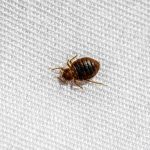What Causes Bed Bugs: An Insight into These Nocturnal Pests
Introduction to Bed Bugs
Consider the quiet, stealthy bed bug—an uninvited guest that’s turning homes into a nighttime battleground. These minuscule marauders wreak havoc on your sense of peace, leaving you with sleepless nights and a slew of questions. But what do we really know about this six-legged nuisance? Let’s dive into the world of bed bugs, peeling back the layers of mystery surrounding these nocturnal pests, and understand how diminutive they are and why they’ve become an unwelcome fixture in our modern lives.
Bed bugs, for starters, have been around for centuries, outliving empires and seeing civilizations rise and fall. Today, they’re found virtually everywhere, from five-star hotels to quaint country inns, and no, it’s not your lack of cleanliness that’s to blame. In fact, bed bugs are hitchhikers extraordinaire, latching onto luggage, clothes, and furnishings to reach new horizons. They’re drawn not to dirt, but to warmth, carbon dioxide, and the blood they need to survive—making humans prime targets for their midnight feasting.
Why should you care about these bedfellows? For one, their bites leave itchy, red welts that can cause allergic reactions and mental distress. Additionally, swiftly identifying them can save you from a prolonged and costly battle to reclaim your serene slumber. So, it’s not just about the ick factor; it’s about understanding the adversary to protect your household and peace of mind.
Intrigued yet? Observe these masters of disguise in action and learn why they’re not the roommates you want.
We invite you to continue exploring this topic, equipping yourself with knowledge and strategies to stay one step ahead of these bloodthirsty critters. Remember, bed bugs may not transmit diseases, but their impact on your wellness and wallet can be substantial. Stay vigilant!
Understanding Bed Bug Infestations
Ever wonder how your squeaky-clean home became a midnight snack bar for bed bugs? It’s like these irritating intruders have a road map to our bedrooms. But what really causes bed bug infestations? The usual culprits are travel, pre-loved furniture, and—let’s face it—a bit of naiveté about these critters. So, let’s unpack these causes, shall we?
Travel: The Bed Bugs’ Free Ride
Imagine a world where travel is free. Sounds great, right? Well, for bed bugs, it’s a reality. Your luggage and hotel stays could be their ticket to a new home—yours. These little stowaways are master hitchhikers, hiding in seams and crevices, eagerly waiting to unpack at their final destination. Do you remember that charming bed and breakfast you stayed at? Yup, could’ve been a bed bug bonanza.
Secondhand Furniture: A Thrifty Trap
Bargains can come with more than just a good price tag. That vintage sofa or antique nightstand might be harboring some unwanted guests. Let’s paint a picture: You find the perfect piece of furniture, but unbeknownst to you, it’s a Trojan horse for bed bugs ready to invade your fortress. Fast forward, and now you’re playing host to a full-blown bed bug party in your living room.
Lack of Awareness: A Bug’s Best Friend
It’s easy to mistake these minute menaces for crumbs or bits of fluff. One of the biggest reasons bed bugs get to break bread—or rather, skin—at our expense is our lack of awareness. Is that a bed bug or a speck of dirt? Hard to say if you’re not up to speed on what these pests look like or the signs of their freeloading ways. That’s why it’s vital to know the enemy—and when it comes to bed bugs, knowledge is more than power; it’s prevention.
While we’re talking shop about nocturnal nuisances, why not check out some efficient detection strategies & tips? Trust me, it’s better to be safe than sorry and covered in itchy bites.
And if you’re more of a visual learner, take a gander at this video—it’s like a mini-documentary on these six-legged hijackers.
Travel-Related Bed Bug Concerns
It’s a truth universally acknowledged that a traveler in possession of luggage must be in want of pest-free accommodation. Yet, staying safe in hotels is more challenging than one might expect. While travel broadens the mind, it unfortunately also broadens the reach of bed bugs, crafty critters that revel in the chaos of human movement. Let’s unpack this pesky situation.
Ever returned from a trip and noticed unfamiliar bites or spots on your bedding? Bingo! You might have unwittingly transported some hitchhiking bed bugs. These uninvited souvenirs are notorious for loitering in the nooks and crannies of hotel rooms, lying in ambush for the next hapless traveler. They’re not fussy about the star rating of your accommodation—they’re just as content in plush suites as they are in modest motels.
Picture this: A globe-trotter, exhausted from adventures, collapses onto their hotel bed. Little do they know, their room harbors tiny trespassers eager to pounce. And when it’s time to go home, these pesky pests are stowaways in the seams of suitcases, creases of clothing, and even tucked away in travel trinkets. Short of an ‘all clear’ from a sniffer dog, how can a jet setter stay ahead of this stealthy menace? Vigilance is key—regular inspections of luggage and hotel beds, plus the use of protective covers, can help you evade your minuscule adversaries.

Now, don’t let the fear of clandestine critters curb your wanderlust. Simple precautions can go a long way. Before zipping up your bags and heading out, consider encasing your luggage in protective bags. Upon arriving at your temporary quarters, don’t just fling your possessions about; conduct a thorough scan of the room. Look for signs of bed bugs—think tiny blood spots or the insects themselves, often lurking around edges of mattresses or behind headboards.
And remember, these nuisances are not exclusive to our nighttime havens; they could be lounging in the plush seats of planes, trains, and buses, eagerly awaiting their next host. So, keep your belongings close and your eyes peeled for any critter that might fancy a free ride to your abode.
While it’s all about being smart and alert, don’t let paranoia take hold. Armed with knowledge and precautionary tactics, you’re well-equipped to prevent these voyaging vampires from turning your homecoming into a horror story. Safe travels, and keep those bags bug-free!
The Role of Secondhand Items in Bed Bug Problems
Welcome to the domain of sneaky critters and clandestine crawlers—yes, we’re delving into the world of bed bugs and their uncanny ability to turn secondhand treasures into tiny Trojan horses. These pesky insects don’t discriminate when it comes to real estate; your lush velvet sofa or that charming vintage wardrobe can just as easily become their new condominium. But worry not, intrepid homeowner, for with knowledge comes power—the power to halt these nocturnal nuisances in their tracks!
Picture this: you’ve just snagged an incredible deal on a secondhand armchair that would give any Pinterest-worthy living room a run for its money. The catch? It might come with some uninvited guests—bed bugs. These unassuming items can serve as the perfect hideouts for bed bugs, quietly biding their time until they can claim your home as their own. From the seams of antique settees to the nooks of repurposed bookshelves, secondhand furnishings are potential carriers of these crafty critters.

But before you swear off secondhand splurges for good, let’s arm ourselves with strategies to safely integrate these finds into our abodes. Case in point: inspect before you invest! When perusing for pre-loved pieces, channel your inner Sherlock and scrutinize every inch for signs of bed bugs. Red flags include tiny black spots, itty-bitty shed skins, or the bugs themselves—brownish insects about the size of an apple seed.
Once you’ve played detective and cleared an item, don’t let your guard down just yet. Think of your entryway as a decontamination zone. Isolate your new addition and consider treating it with heat, steam, or encasements specifically designed to send bed bugs packing. For those particularly priceless pieces, perhaps a professional intervention is in order. Pest control experts can be the guardians of your peace of mind, ensuring your latest gem is bed bug-free.
So there we have it, friends—while secondhand items can indeed be havens for bed bugs, they needn’t be a no-go. With a bit of vigilance and some savvy prep, you can weave these unique elements into your home tapestry without falling prey to the patterns of these nocturnal pests. By keeping bed bugs at bay, your home remains a sanctuary, unfettered by the woes of what causes bed bugs to thrive.
Myths vs. Facts About Bed Bug Causes
When it comes to bed bugs, misinformation can spread faster than a New York minute. Let’s set the record straight and separate the fact from fiction. No, bed bugs aren’t a sign of dirtiness and they don’t just magically appear out of thin air. What they are is opportunistic hitchhikers that can latch onto luggage, clothing, and furniture, eagerly awaiting to invade your personal space.
Contrary to the old wives’ tales, bed bugs are not drawn by garlic breath or a full moon but by the carbon dioxide exhaled by potential hosts. It’s not about poor housekeeping but global travel and second-hand furniture sales that boost their spread. Imagine a lovely vintage armchair, just perfect for your living room, but unbeknownst to you, it houses a tiny army ready to take over. This is how easily bed bugs can turn your home into their playground.

Now here’s a fact that might surprise you: bed bugs are not exclusively nocturnal. They adapt to the sleeping patterns of their food source. You work the night shift? They’ll gladly adjust their dining hours for a daylight feast. This adaptability makes preventing and controlling an infestation quite the challenge.
Education is key in bed bug prevention. Understanding their behavior and habitats is crucial. This fact sheet provides valuable insights on how to outsmart these pesky critters and safeguard your home.
So, next time you hear someone blaming bed bugs on dirty laundry piled up in a corner, you’ll know better. It’s all about staying informed and understanding what you’re really up against. Be vigilant and keep an eye out for the real causes, and you’ll stand a much better chance in the fight against the bed bug brigade.
Identifying Bed Bug Infestations Early On
Ever woken up to a constellation of itchy red welts and thought to yourself, “Hmmm, did I indulge in a midnight snack for some mysterious fanged visitor?” Well, you’re not alone. Early detection of bed bugs is akin to finding a needle in a haystack, but knowing what to look for can save you from a full-blown bug bonanza.

It starts with subtle clues: an unexplained bite here, a speck of blood there, maybe even a lone bug scurrying away when you flick on the lights. Your mission? To spot these signs before your bedroom becomes a bed bug rave. Imagine a Sherlock Holmes investigation, but instead of a pipe and houndstooth cap, you’re armed with a flashlight and a magnifying glass. The first suspects on your lineup? Tiny reddish-brown critters about the size of an apple seed, likely tucked away in the crevices of your mattress, just biding their time.
Not a fan of these late-night feeders? Well, it’s showtime! Start by scrutinizing the seams of your mattress, peek behind the headboard, and inspect the corners of your bed frame. An early red flag could be small rust-colored smears on the sheets – the aftermath of bed bugs meeting their demise as you toss and turn. You can even visit Doctor Sniffs for pro tips on how to spot these elusive bloodsuckers.
Treasure hunting for bed bugs is the last thing anyone wants to do with their spare time. However, catching these critters in the act early on could mean the difference between a minor guest eviction and a full-blown pest occupation. Keep an eye out for the telltale signs, and you could nip the problem in the bud, preserving the sanctity of your slumber party for one.
Strategies for Preventing Bed Bug Infestations
Imagine waking up to a nightmare of itchy bites and reddish stains on your sheets. Yes, we’re talking about bed bugs, those unwelcome guests that sneak into our sanctuaries and turn restful nights into restless itch-a-thons. But fear not! Let’s explore some strategies to keep these nocturnal nuisances at bay.
First things first, cleanliness is key. Bed bugs are opportunistic travelers and love to hitch a ride on second-hand furniture, luggage, and even clothes. So, think twice before snagging that “vintage” couch off the curb! Make it a habit to inspect second-hand items before bringing them into your home. And remember, vacuuming regularly is your first line of defense. It’s like telling bed bugs, “Not today, pests!”
Now, let’s talk about fortifying your fortress—aka your bed. Encase your mattress and box springs with protective covers. These are the bed bug equivalents of a moat around a castle. When you sleep, you become a less tempting target for those pesky biters. Let your bed be a cloud of tranquility, not a battlefield.
Decluttering is another tactic that’s simple yet effective. Less clutter means fewer hiding places for bed bugs. It’s like playing a game of hide and seek, and suddenly, all the good hiding spots are gone! Keep your place tidy, and bed bugs will have to search elsewhere for a cozy hideout.
Alright, let’s get real for a moment. Have you ever gone to the movies and felt an itchy sensation after the lights came on? Bed bugs love to catch flicks too, and sometimes they can follow you home! So, when you’re out and about, be mindful of your surroundings. A quick check of your seat might save you from an unwanted sequel: “The Return of the Bed Bugs.”
Lastly, are you ready for a pro-tip? Heat treatment. These critters hate the heat. Once in a while, treat your clothes and bedding to a spa day in the hot wash. And when you travel, use luggage racks to keep your bags off the floor, because bed bugs are more about “B&B” (Bed & Bedding) and less about “RR&R” (Rest, Relaxation & Roaming).
So, you see, we can outsmart these little invaders. Staying vigilant and resorting to these simple yet effective strategies can help maintain your home as a bed bug-free zone. And now, for a visual guide on stopping these critters, check out this informative video:
By now, you’ve got the knowledge to tackle what causes bed bugs and the power to prevent them from turning your home into their playground. Get proactive and keep your living spaces as uncomfortable for bed bugs as possible; after all, they’re the guests that should never make it past the welcome mat!
Professional Pest Control: When to Call in the Experts
Realizing that bed bugs have infested your home can be a nerve-wracking discovery. These tiny, elusive pests can hide in the smallest crevices and only come out to feast when you’re fast asleep, making them particularly difficult to eradicate. While minor infestations may tempt you to tackle the problem using DIY methods, there comes a time when professional pest control services become a necessity.
Imagine you’ve just come back from a much-needed vacation, only to notice itchy welts across your skin and tiny blood spots on your sheets. Despite launderings and over-the-counter sprays, the telltale signs of bed bugs remain. This real-life scenario is a clear sign that the bed bugs are not just visitors—they’ve made themselves at home. When you’ve reached the point of multiple sightings and continuous bite marks, it’s time to call in the experts.

Certified pest control professionals are equipped with the knowledge, tools, and techniques to offer effective solutions. They conduct a thorough inspection, often uncovering the true scale of an infestation that might be far larger than initially assumed. If you’ve been playing a losing game of hide-and-seek with bed bugs, chances are they are entrenched in areas beyond your mattress, possibly in the cracks of the baseboards, behind wallpaper, or inside electrical outlets.
A single pregnant bed bug can lead to hundreds within a matter of weeks. If you see bed bugs during the day or find them in multiple rooms, it’s a glaring red flag—the infestation has reached a critical level. Unlike other household pests that you might attempt to control on your own, bed bugs are persistent and can survive up to a year without a meal. Their resilience and the potential for rapid population growth make them formidable opponents for even the most ardent DIY enthusiast.
Professional pest control services offer treatments that aren’t typically available to the public, such as heat treatments that raise the temperature of your home to a level that is lethal to bed bugs in all stages of life. Experts also offer fumigation and deep chemical treatments that penetrate potential hiding spots, ensuring that these stubborn pests are addressed once and for all. It’s not simply about the treatment itself, but also about their strategic approach and follow-up, which often include a detailed plan for prevention of future infestations.
Remember, bed bugs are not a reflection of cleanliness or living standards. These pests hitch rides in luggage, furniture, and clothing, and can infest any home, regardless of how immaculate it is. When the standard cleaning and over-the-counter products fail to eliminate them, it’s not a defeat; it’s a call to action. A professional pest control service is your ally in reclaiming your home from these nocturnal invaders—one where you can rest assured that every last bed bug has been dealt with, and you can finally get a good night’s sleep.
Frequently Asked Questions
When it comes to bed bugs, everyone’s got questions. Are they hitching a ride on your suitcase? Invading your home through that second-hand couch you just brought in? Let’s clear the air with some straight talk about these night-time nuisances.
How Do Bed Bugs Enter Our Homes?
Imagine coming home from a vacation. You had a blast, but without knowing it, you might have brought back a few uninvited guests. Bed bugs are world-class hitchhikers, clinging onto your luggage or clothing from hotel rooms or public transport. And it’s not just travel; purchasing used furniture can unknowingly introduce bed bugs into your sanctuary.

Is It True That Bed Bugs are Drawn to Filth?
This is a common misconception. Bed bugs aren’t attracted to dirt or decay. They are simple creatures with a one-track mind: They want your blood. Clean or cluttered, spick and span, or slightly slovenly—it doesn’t matter to them. Neat freaks and those a tad more laid-back are all equally susceptible to bed bug infestations.
Do Bed Bugs Spread Disease?
Here’s a bit of good news: While bed bugs are a major nuisance and can cause itchiness and loss of sleep, they are not known to spread diseases. However, that doesn’t mean they’re harmless. They can cause allergic reactions and psychological distress. Always best to give these critters the boot as soon as you spot one!
Can Bed Bugs Live in My Electronics?
It might sound bizarre, but yes, bed bugs can take refuge in electronics and appliances, laying low until the coast is clear. They’re not after your gadgets—they’re waiting for you. Warmth and crevices are all they need, and your laptop vents or game consoles can provide just that.
What Are the Best Practices for Dealing with Bed Bugs?
Firstly, keep calm and don’t panic. It’s a problem that can be tackled. Start by stripping your bed and washing everything in hot water. Vacuum your place meticulously, paying close attention to nooks and crannies. Consult with pest management professionals for a thorough solution—these critters can be tough to beat, but with the right approach, they’re beatable.








